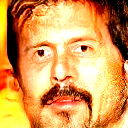 Посмотреть на TensorFlow.org Посмотреть на TensorFlow.org |  Запускаем в Google Colab Запускаем в Google Colab |  Посмотреть на GitHub Посмотреть на GitHub |  Скачать блокнот Скачать блокнот |  См. Модель TF Hub См. Модель TF Hub |
Этот Colab демонстрирует использование модуля TF Hub на основе генеративной состязательной сети (GAN). Модуль отображает N-мерные векторы, называемые скрытым пространством, в изображения RGB.
Приведены два примера:
- Отображение от скрытого пространства изображений, а также
- С учетом целевого изображения, используя градиентный спуск , чтобы найти скрытый вектор , который формирует изображение , аналогичное требуемое изображение.
Необязательные предпосылки
- Знакомство с низким уровнем концепций Tensorflow .
- Generative Состязательность Network в Википедии.
- Бумага на прогрессивных Gans: Progressive Выращивание Gans для улучшения качества, стабильности и вариации .
Больше моделей
Здесь вы можете найти все модели в настоящее время размещенных на tfhub.dev , которые могут генерировать изображения.
Настраивать
# Install imageio for creating animations.pip -q install imageiopip -q install scikit-imagepip install git+https://github.com/tensorflow/docs
Импорт и определения функций
from absl import logging
import imageio
import PIL.Image
import matplotlib.pyplot as plt
import numpy as np
import tensorflow as tf
tf.random.set_seed(0)
import tensorflow_hub as hub
from tensorflow_docs.vis import embed
import time
try:
from google.colab import files
except ImportError:
pass
from IPython import display
from skimage import transform
# We could retrieve this value from module.get_input_shapes() if we didn't know
# beforehand which module we will be using.
latent_dim = 512
# Interpolates between two vectors that are non-zero and don't both lie on a
# line going through origin. First normalizes v2 to have the same norm as v1.
# Then interpolates between the two vectors on the hypersphere.
def interpolate_hypersphere(v1, v2, num_steps):
v1_norm = tf.norm(v1)
v2_norm = tf.norm(v2)
v2_normalized = v2 * (v1_norm / v2_norm)
vectors = []
for step in range(num_steps):
interpolated = v1 + (v2_normalized - v1) * step / (num_steps - 1)
interpolated_norm = tf.norm(interpolated)
interpolated_normalized = interpolated * (v1_norm / interpolated_norm)
vectors.append(interpolated_normalized)
return tf.stack(vectors)
# Simple way to display an image.
def display_image(image):
image = tf.constant(image)
image = tf.image.convert_image_dtype(image, tf.uint8)
return PIL.Image.fromarray(image.numpy())
# Given a set of images, show an animation.
def animate(images):
images = np.array(images)
converted_images = np.clip(images * 255, 0, 255).astype(np.uint8)
imageio.mimsave('./animation.gif', converted_images)
return embed.embed_file('./animation.gif')
logging.set_verbosity(logging.ERROR)
Скрытая пространственная интерполяция
Случайные векторы
Скрытая пространственная интерполяция между двумя случайно инициализированными векторами. Мы будем использовать модуль TF Hub progan-128 , который содержит предварительно подготовленный Progressive ГАН.
progan = hub.load("https://tfhub.dev/google/progan-128/1").signatures['default']
def interpolate_between_vectors():
v1 = tf.random.normal([latent_dim])
v2 = tf.random.normal([latent_dim])
# Creates a tensor with 25 steps of interpolation between v1 and v2.
vectors = interpolate_hypersphere(v1, v2, 50)
# Uses module to generate images from the latent space.
interpolated_images = progan(vectors)['default']
return interpolated_images
interpolated_images = interpolate_between_vectors()
animate(interpolated_images)

Поиск ближайшего вектора в скрытом пространстве
Исправьте целевое изображение. В качестве примера используйте изображение, созданное из модуля, или загрузите свое собственное.
image_from_module_space = True # @param { isTemplate:true, type:"boolean" }
def get_module_space_image():
vector = tf.random.normal([1, latent_dim])
images = progan(vector)['default'][0]
return images
def upload_image():
uploaded = files.upload()
image = imageio.imread(uploaded[list(uploaded.keys())[0]])
return transform.resize(image, [128, 128])
if image_from_module_space:
target_image = get_module_space_image()
else:
target_image = upload_image()
display_image(target_image)

После определения функции потерь между целевым изображением и изображением, созданным переменной скрытого пространства, мы можем использовать градиентный спуск, чтобы найти значения переменных, которые минимизируют потери.
tf.random.set_seed(42)
initial_vector = tf.random.normal([1, latent_dim])
display_image(progan(initial_vector)['default'][0])

def find_closest_latent_vector(initial_vector, num_optimization_steps,
steps_per_image):
images = []
losses = []
vector = tf.Variable(initial_vector)
optimizer = tf.optimizers.Adam(learning_rate=0.01)
loss_fn = tf.losses.MeanAbsoluteError(reduction="sum")
for step in range(num_optimization_steps):
if (step % 100)==0:
print()
print('.', end='')
with tf.GradientTape() as tape:
image = progan(vector.read_value())['default'][0]
if (step % steps_per_image) == 0:
images.append(image.numpy())
target_image_difference = loss_fn(image, target_image[:,:,:3])
# The latent vectors were sampled from a normal distribution. We can get
# more realistic images if we regularize the length of the latent vector to
# the average length of vector from this distribution.
regularizer = tf.abs(tf.norm(vector) - np.sqrt(latent_dim))
loss = target_image_difference + regularizer
losses.append(loss.numpy())
grads = tape.gradient(loss, [vector])
optimizer.apply_gradients(zip(grads, [vector]))
return images, losses
num_optimization_steps=200
steps_per_image=5
images, loss = find_closest_latent_vector(initial_vector, num_optimization_steps, steps_per_image)
.................................................................................................... ....................................................................................................
plt.plot(loss)
plt.ylim([0,max(plt.ylim())])
(0.0, 6696.301751708985)

animate(np.stack(images))

Сравните результат с заданным:
display_image(np.concatenate([images[-1], target_image], axis=1))

Играем с приведенным выше примером
Если изображение взято из пространства модуля, спуск происходит быстро и сходится к разумному образцу. Попробуйте спускающийся к изображению, которое не из пространства модулей. Спуск будет сходиться только в том случае, если изображение достаточно близко к пространству обучающих изображений.
Как сделать так, чтобы он спускался быстрее и к более реалистичному изображению? Можно попробовать:
- используя различные потери на различии изображений, например квадратичные,
- используя другой регуляризатор на скрытом векторе,
- инициализация из случайного вектора за несколько запусков,
- и Т. Д.

